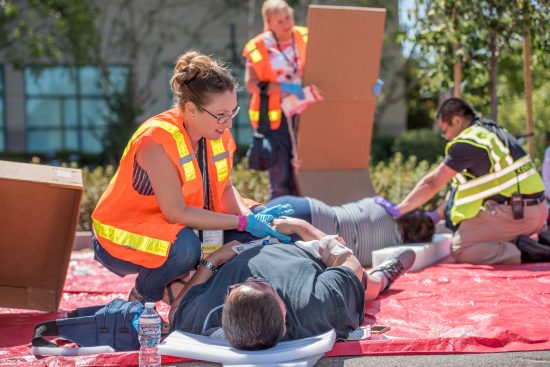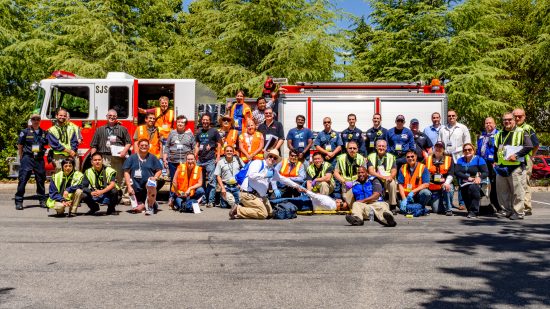I’m a sailor. As a matter of fact, my family and I sailed around the world a few years ago.
We sailed 16,000 nautical miles from San Francisco to Europe, including through the Panama Canal and across the Atlantic Ocean. I had a lot of time to think about people in crisis, how to respond and the people who come to help. When you’re out at sea, you have to rely on yourself, and you know that if you ever do get into real trouble, other people will be putting their own lives at risk to save you.
Whenever possible, “Cruisers” as full time sailors are called, help each other out. Once we ran aground in the Aeolian Islands off of Sicily, and two boats (one French and one British) helped us off. We paid it forward later that year to a French boat who ran aground in the Balearic Islands of Spain.
We experienced many heavy weather scenarios including severe gales, thunderstorms, hurricane force winds and other scary or uncomfortable situations – but nothing that was considered a “survival” situation. I can tell you that being at the helm in severe weather conditions with your family down below makes you quickly realize what’s important. And it’s not that deadline at work.

That’s originally why I joined Cisco’s Emergency Response Team. I wanted to learn CPR and emergency response skills to augment my safety skills at sea. However, I stayed on the team because they, too, are ready to risk their safety to help their colleagues.
Upon coming back to work at Cisco, I immediately signed up again for the Emergency Response Team, with a renewed sense to help.
I re-trained in CPR and First Aid and my first big opportunity was to participate in an Operational Readiness Drill. An Operational Readiness Drill (ORD) is an annual exercise to test Cisco’s abilities to respond to a large-scale multi-casualty incident. Scenarios used in previous exercises included explosions, earthquakes, vehicle accidents, and plane crashes. Cisco even involves the local fire department and county EMS as participants. To make it as realistic as possible, “players” sign up to respond to the incident, while “actors” pretend to be injured, complete with realistic make-up.

The day of the ORD, the volunteers got a text that there was an earthquake and “more ERT” were needed at the site. Over the next few hours I was tasked with trying to find someone reportedly injured in a building (no luck), performing a triage assessment of multiple injured people, and doing my best to make sense out of a situation that the organizers did their best to make very chaotic – and therefore more realistic.

On my way over to responding to the event, I asked myself, “Would I be running toward danger in a real emergency, not knowing if my family was safe?” In our post-drill discussion, our Emergency Preparedness and Response Coordinator told us, “Safety begins at home.” It was a good reminder. I might be prepared for anything at sea, but I need to also be as well prepared for anything at home. It’s time to dust off the family emergency preparedness plan and get my earthquake kit at home and in the car.
I love that Cisco has a dedicated team thinking about, and preparing for disasters. I love that Cisco involves volunteers who want to help. I love that Cisco realizes what’s most important: its people.
Want to join a company where people are the key? See open opportunities at Cisco.
Read more about Jennifer’s sailing around the world adventure.


You are a rockstar! Cisco makes it so easy for us to find our passion and give back. I might even check this team out. Thanks, Jen!
Great blog post, and a very cool story about learning one skill and running with it for a greater purpose. Plus, love the red fire truck photo. 😉
Great post! It’s comforting to know that we have such experienced and capable ORD team members ready in the face of an emergency.
Great blog post, Jen! Really inspiring to read about your participation in Cisco’s ERT and the importance Cisco puts on its people.
This is an important reminder that we all need to be prepared at any time. And love that Cisco is ready to help in any situation.
Jen, your sailor’s sensibility for safety and preparedness certainly comes thru. And you strike quite the gallant pose in that fire truck! Loved your inspiring and entertaining write-up. It’s a great first-hand account of how Cisco puts its people first.
What a wonderful way to share your calm-under-pressure expertise with others. Cisco is lucky to have you back ‘in action’.
Jen rocks!
Good one,and an important subject- keeping people safe. Glad to know of Cisco’s program, and people like Jen out there leading the way. Keep it up! (love the fire truck pic too)
I know that girl!!! Jen rules!!!
I see me!
Great story, Jen!
Cisco employees and contingent workers who are interested in the Emergency Response Team program can find out more at http://go2/ert
Jen – you already know that I think you are simply amazing! However, I’m putting you on notice that when I get in any kind of trouble I am calling 1-800-JEN!
I love you and am so very proud of you,
Uncle Fred (aka “married to Ant Gail”)
I’m speechless. And atim a bit speachlessand at the same time … wow.
im a bit speachless and and the same time … wow.